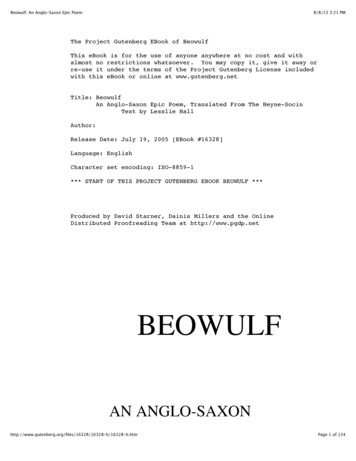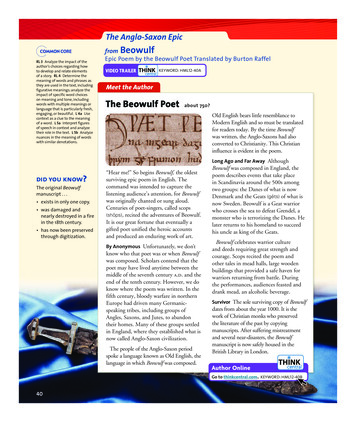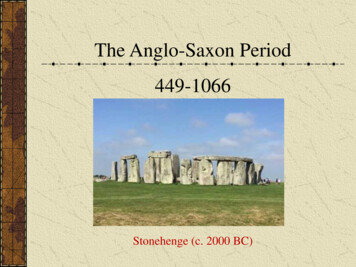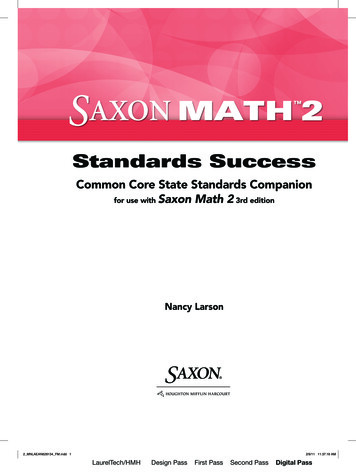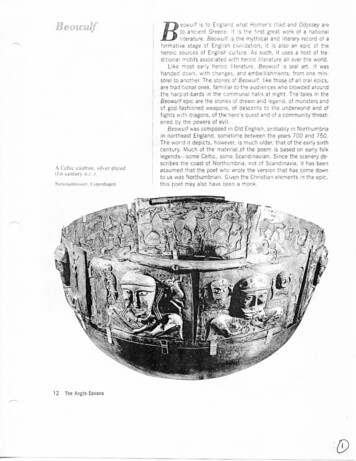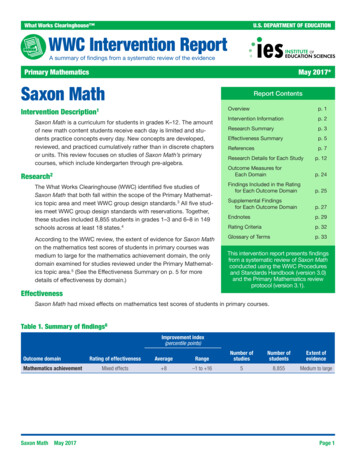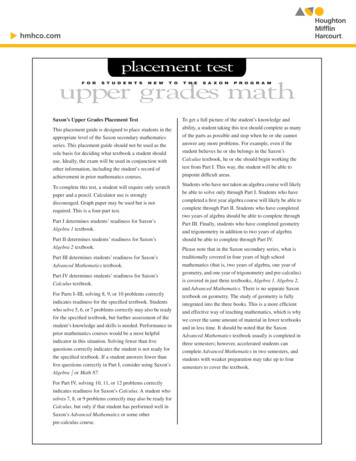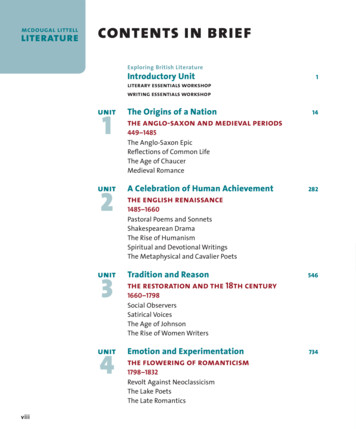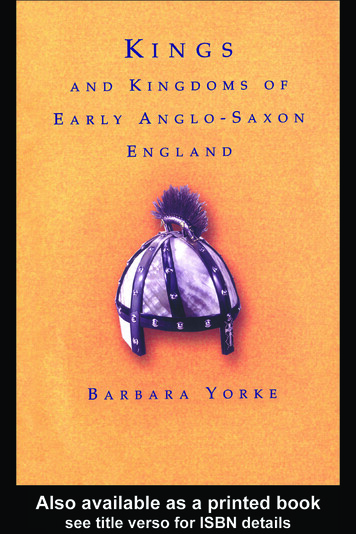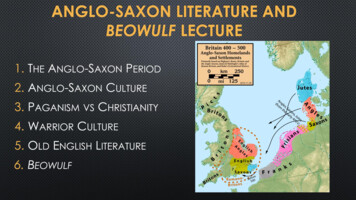
Transcription
ANGLO-SAXON LITERATURE ANDBEOWULF LECTURE1. THE ANGLO-SAXON PERIOD2. ANGLO-SAXON CULTURE3. PAGANISM VS CHRISTIANITY4. WARRIOR CULTURE5. OLD ENGLISH LITERATURE6. BEOWULF
OLD ENGLISH – WHAT IS IT?RECOGNIZE THIS?FÆDER URE ÞU ÞE EART ON HEOFONUM;SI ÞIN NAMA GEHALGODTO BECUME ÞIN RICEGEWURÞE ÐIN WILLAON EORÐAN SWA SWA ON HEOFONUM.URNE GEDÆGHWAMLICAN HLAF SYLE US TODÆGAND FORGYF US URE GYLTASSWA SWA WE FORGYFAÐ URUM GYLTENDUMAND NE GELÆD ÞU US ON COSTNUNGEAC ALYS US OF YFELE SOÞLICE
OLD ENGLISH TO MODERN ENGLISHOld EnglishMiddle EnglishModern EnglishFæder ure şu şe eart on heofonum,Oure fadir şat art in heuenesOur father which art in heaven,si şin nama gehalgod.halwid be şi name;hallowed be thy name.to becume şin rice,şi reume or kyngdom come to be.Thy kingdom come.gewurşe ğin willa,Be şi wille donThy will be doneon eorğan swa swa on heofonum.in herşe as it is dounin heuene.in earth as it is in heaven.urne gedæghwamlican hlaf syle us yeue to us today oure eche dayesGive us this day our daily bread.todæg,bred.And forgive us our trespassesand forgyf us ure gyltas,And foryeue to us oure dettis şat is as we forgive those who trespassswa swa we forgyfağ urumoure synnysagainst us.gyltendum.as we foryeuen to oure dettouris şat And lead us not into temptation,and ne gelæd şu us on costnunge,is to men şat han synned in us.but deliver us from evil.ac alys us of yfele soşlice.And lede us not into temptacionbut delyuere us from euyl.Fun fact: Your favorite guy Shakespeare is consideredModern English.
I. THE ANGLO-SAXON PERIOD (449-1066)THE ANGLO SAXON INVASION 428 CE – BRITON RULER (VORTIGERN) HIRES GERMANIC (SAXON) TROOPS TO REPELINVASIONS FROM PICTS (“PAINTED ONES” - SCOTLAND); VORTIGEN FAILS 449 CE – CONSIDERED THE BEGINNING OF THE ANGLO-SAXON ANGLES (MODERN SOUTHERN DENMARK) SAXON (COASTLANDS JUTES (MODERNOF MODERNMAINLANDGERMANY)DENMARK) BY 600 CE, GERMANIC SPEECH OF ENGLANDHAS BECOME UNIQUE FROM CONTINENTALGERMANIC LANGUAGES.PERIOD
II. ANGLO SAXON CULTURE (449-1066) CULTURE (GERMANIC TRIBES EITHER DROVE OUT THE NATIVES ORMIXED WITH THEM) KINSHIP LORDSHIP COMITATUS HEROIC VIRTUES COURAGE - ABSOLUTE AND RECKLESS) HONOR – AIM IS GLORY, THE FAME OF A “GOOD NAME” LOYALTY TO ONE’S CHIEFTAN PROWESS IN BATTLE DRINKING AT A FEAST
PAGANISM VS CHRISTIANITY RELIGION VIEW OF LIFE IS FATALISTIC; YOU HAVE A FATE AND IT IS GOING TO HAPPEN GODS (BASED ON GERMANIC GODS) WYRD – FATE, EVERYONE, EVEN THE GODS HAD A FIXED, AND UNAVOIDABLE FATE. 597 CE – GREGORIAN MISSION A CLASH OF RELIGIONS MOST OF SOUTHERN ENGLAND TOCHRISTIANITY BY 650.
CULTURAL ARTIFACTS AND SUTTON HOO SUTTON HOO – 7TH CENTURY BURIAL MOUNDS THE SHIP-BURIAL DISCOVERED UNDER MOUND 1 IN 1939CONTAINED ONE OF THE MOST MAGNIFICENT ARCHAEOLOGICALFINDS IN ENGLAND FOR ITS SIZE AND COMPLETENESS. FROM SUTTON HOO WE LEARNED BURIAL PRACTICES BELIEF IN AN AFTERLIFE MIXINGOF PAGAN ANDCHRISTIANTRADITIONS AS WE READ BEOWULF, TWO FUNERALS ARE DESCRIBED FOR US.CONSIDER THE SIMILARITES OF SUTTON HOO TO THEBURIALS IN THE POEM. HOW ARE THESE IMPORTANT TO THEINTERMINGLING OF CHRISTIAN AND PAGAN TRADITIONS?
Model of the the shipsoutline and how it mighthave appeared with thechamber area outlined inwhite.
Recreation of the burialchamber, which wasdesigned like a room inthe king’s house.
Warrior and horse buried with theking (horse sacrificed to travel withhim into the afterlife)Mystery spoons – read “Salvos”(Saul) and “Pavlos” (Paul) – Noone knows why they’re there,but it reveals the co-existenceof pagan religion andChristianity at this point inAnglo-Saxon history
Purse lid and shoulder clasp from Sutton Hoo, 7th centuryBelt buckles from Sutton Hoo, 7th century
DANISH INVASION, ENGLISH UNIFICATION, AND NORMAN CONQUEST 871 CE – ALFRED THE GREAT TAKESTHE THRONE BATTLES WITH THE DANES (VIKINGS) IMPORTANCE OF CHRISTIANITY INUNIFICATION OF ANGLO SAXONSAND THE DANES 1066 – NORMAN INVASION –DEFEATS BOTH THE ANGLO-SAXONSAND THE DANES; END OF THEANGLO-SAXON PERIOD
OLD ENGLISH LITERATURE STILL SEEING ORAL TRADITIONS AS DISCUSSEDWITH THE ANCIENT GREEKS SCOPS – THE BARD OR POET TELLING THE STORY WHAT HAS BEEN LOST OR ADDED INTRANSLATION? RUNES – PRIMARILY USED IN INSCRIPTIONS ANGLO-SAXON VERSE HEROIC - BEOWULF HISTORICAL – “THE BATTLE OF MALDON” THERE ARE OTHERS, BUT WE WILL NOT STUDYTHEM.
TRAITS OF ANGLO-SAXON VERSEAND OTHER O.E. POETRY TERMS ALLITERATION CAESURA COMITATUS KENNING LITOTES UBI SANT
Beowulf only survives in onemanuscript, called the CottonVitellius It was damaged in theAshburnham House (part ofWestminster School in London)fire of 1731. (A unique copy of“The Battle of Maldon” wasdestroyed) The manuscript contains otherOld English poems, a sermon, awork about Aristotle, and anillustrated collection of beasts andmonsters.
The original composition of Beowulfis also a matter of controversy. Who?When? Where? We don’t knowprecisely. The date is a subject of controversy,but it is at least 1,000 years old. Somescholars argue the 8th century; othersthe 10th or 11th. The problematic Pagan/ Christiannature of the poem is also a matter ofmuch scholarly debate.
As you we read we will examine Epic hero/poetry elements (refer to Iliad notes as necessary) The virtues of Anglo Saxon culture Look for Pagan and Christian elements Look for what the poet celebrates (What is seen as heroic? What isseen as honorable behavior? What is criticized and why?) Look for connections that can be made to other texts Look for style elements (repetition, theme, epic conventions, etc.) Consider STRUCTURE (We will beexamining different elements of ring structure in this poem)
“THE BATTLE OF MALDON” YOU WILL BE WORKING IN GROUPS TO CREATE A STORYBOARD OF “THE BATTLE OF MALDON” BASEDON YOUR GROUP’S ASSIGNED ELEMENT OF ANGLO SAXON POETRY.- COMITATUS- HONORABLE VS DISHONORABLE BEHAVIOR IN BATTLE- ELEMENTS OF PAGANISM VS CHRISTIANITY- IMPORTANT BATTLE MOMENTS (YOU MAY WANT TO READ THEHISTORICAL INFORMATION AT THE BEGINNING TO HELPBIT OFYOU MAKE CONNECTIONS)- CONNECTIONS (SIMILARITIES/DIFFERENCES) OF “THE BATTLE OFMALDON” TO “THE SEAFARER,” “THE WANDERER,” AND THEILIAD.
i. the anglo-saxon period (449-1066) the anglo saxon invasion 428 ce –briton ruler (vortigern) hires germanic (saxon) troops to repel invasions from picts (“painted ones” - scotland); vortigen fails 449 ce –considered the beginning of the anglo-saxon period angles (modern southern denmark) saxon (coastl

